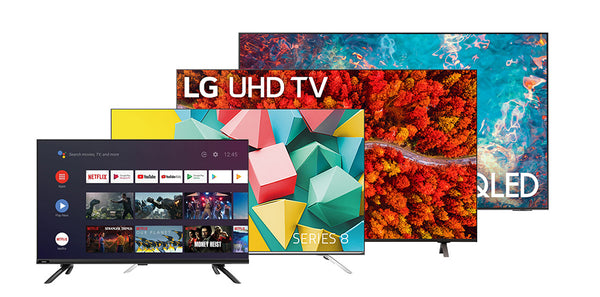Buying a new TV? One of the biggest factors affecting picture quality is resolution—but what does that actually mean? With terms like HD, Full HD, 4K, and 8K thrown around, it can be confusing to know what’s best for your setup.
Understanding TV resolution types will help you make an informed choice, whether you’re after a small screen for a bedroom or a large-screen 4K TV for your living room. Bigger resolution means a sharper, more detailed image, but there’s more to it than just numbers.
Strap in lads, it’s about to get techy.
What is TV resolution?
TV resolution refers to the total number of pixels that make up the image on a TV screen. Pixels are tiny dots of colour that work together to create the picture you see. The higher the resolution, the more pixels there are, resulting in sharper picture quality and finer details.
Higher screen resolution is especially important for larger TVs, where lower resolutions can look blurry or pixelated. More pixels create a clearer, more detailed image, making resolution a key factor in picture quality.
Why Does TV Resolution Matter?
A TV’s resolution affects how clear and detailed the picture looks. More pixels mean a sharper, more realistic image, which makes a difference whether you're watching sports, movies, or gaming.
Resolution vs. Refresh Rate vs. Panel Type
While resolution affects image clarity, other things also impact how good your TV looks:
- Refresh Rate (Hz): A higher refresh rate (like 120Hz) makes motion smoother, which is great for sports and gaming.
- Panel Type: Technologies like OLED, QLED, NanoCell, and Mini LED affect colour, brightness, and contrast. More on those here.
When choosing a TV, resolution matters, but it’s best when combined with a good refresh rate and the right panel type.
HD & Full HD: Still Kicking, But Mostly for Smaller Screens
Once the gold standard, 720p HD TVs (1280 × 720 pixels) are now mostly found in budget models or small smart TVs. They do the job, but most brands have moved on to higher resolutions.
1080p Full HD (1920 × 1080 pixels) Was dominating the TV scene for years! Perfect for streaming, gaming, and everyday viewing. While it's still around, you’ll mostly see it in smaller TVs (24”–32”), making it a solid pick for kitchens, caravans, or kids' rooms. Browse our range of small TVs.
For Aussies who rely on free-to-air TV (which still broadcasts in 1080p or lower), a Full HD (FHD) TV could work just fine. But if you’re into streaming, gaming, or future-proofing, 4K is the smarter choice.
4K UHD: Ultra High Definition
These days, 4K UHD TVs are the standard. Every major brand now makes 4K resolution the baseline, offering four times the pixels of a 1080p Full HD TV. This results in sharper details, richer colours, and a clearer picture, making 4K the best choice for most buyers.
You'll find 4K TVs in a wide range of screen sizes, from mid-sized models to large screens for home theatres. If you're worried about room size, don’t be! 4K pixels are so small you won’t notice them up close, so you can sit closer to the screen without losing quality. If you’re unsure what size to get, check out my TV size guide (spoiler alert: go big).
Why HDR Matters for 4K TVs
One of the biggest upgrades with 4K UHD TVs is HDR (High Dynamic Range), which enhances contrast, brightness, and colour accuracy for a more lifelike image. There are different types of HDR technology, including:
- HDR10 – The most common standard, supported by most 4K TVs and streaming services.
- Dolby Vision – A premium version with dynamic scene-by-scene adjustments for better contrast and colour.
- HLG (Hybrid Log-Gamma) – Used for live TV broadcasts, making sports and live events look more vibrant.
When choosing a 4K TV, check which HDR formats it supports to get the best picture quality.
What Internet Speed Do You Need for 4K Streaming?
If you're watching free-to-air TV, DVDs, or Blu-rays, internet speed doesn’t matter at all—your picture quality comes from the TV itself. But if you’re streaming 4K content on Netflix, Disney+, or YouTube, a good internet connection is key to avoiding buffering.
- 25 Mbps – Minimum for most 4K streaming services.
- 50 Mbps or higher – Ideal for smooth playback, especially if multiple devices are connected.
You can check your Mbps on websites like - https://www.speedtest.net/
For regional Australians, where internet speeds can be slower, consider a wired Ethernet connection or a fast NBN plan for the best 4K streaming experience.
Why 4K UHD is the Best Choice for Most Buyers
With more 4K content than ever, advanced HDR technology, and affordable options across all major brands, 4K UHD TVs offer the best balance of performance, quality, and price.
Ready to buy? Browse our range of 4K TVs available at Bi-Rite.
8K UHD: The Future of TV Resolution
8K TVs have four times the pixels of 4K TVs, making the picture incredibly sharp and detailed. With such a high resolution, everything on screen looks more lifelike and realistic, almost as if it’s happening in your living room.
Since 8K is new technology, these TVs come with a premium price tag and are best for early adopters who want the latest in TV resolution. The pixels are so small that you can’t see them, creating an ultra-clear image with smooth edges and fine details.
Right now, there isn’t much 8K content available. However, 8K TVs include upscaling technology, which improves Full HD (FHD) and 4K content to near-8K quality. This means you can still watch your favourite shows and movies with better sharpness and clarity, even if they weren’t filmed in 8K resolution.
At this stage 8K is available in top range or premium models for most major brands so if you’re after the best TVs that are currently available then you can’t go past 8K.

Making the Right Choice for Your Next TV
If you’re upgrading your TV, we highly recommend 4K. It’s now the standard resolution, and most TV shows, movies, and games are made to take full advantage of 4K quality. Whether you're watching Netflix, playing on a gaming console, or enjoying live sports, 4K UHD will give you the best experience.
When choosing a TV, think about:
- Your budget – 4K TVs come in a wide price range, from affordable entry-level models to premium high-end screens.
- Your viewing habits – If you mostly watch streaming services, sports, or game on next-gen consoles, a 4K TV with HDR is a great investment.
- Your space – 4K TVs work well at any size, and because the pixels are so small, you can sit closer without losing clarity.
For most people, a 4K UHD TV offers the best balance of performance, price, and future-proofing. If you’re still unsure, come in-store to see the difference for yourself and chat with our experts!


